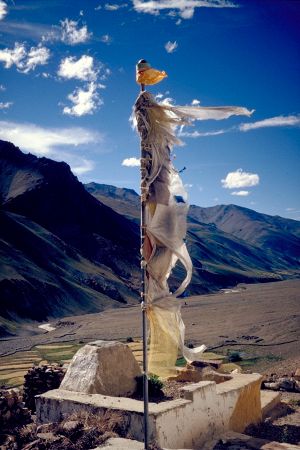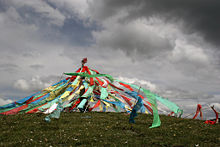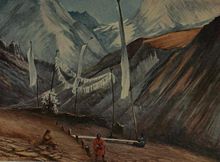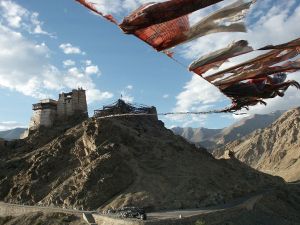Difference between revisions of "Prayer flag" - New World Encyclopedia
Dan Davies (talk | contribs) |
Dan Davies (talk | contribs) |
||
| Line 58: | Line 58: | ||
Image:Nepal Prayer flag.jpg|The Solukhumbu region, looking back at a brilliant Lhotse and Everest shining in the rare (in April) evening sun behind a prayer flag pole. | Image:Nepal Prayer flag.jpg|The Solukhumbu region, looking back at a brilliant Lhotse and Everest shining in the rare (in April) evening sun behind a prayer flag pole. | ||
Image:Prayer flags Gangtok Sikkim.jpg|En route to the main monastery in Gangtok (Sikkim) India. | Image:Prayer flags Gangtok Sikkim.jpg|En route to the main monastery in Gangtok (Sikkim) India. | ||
| + | Image:Small Tibetan prayer flags.jpg|Tibetans believe that the prayers (or blessings) printed on each flag in Tibetan script are activated by the physical motion of blowing wind and are thus transmitted outward into the cosmos. The flags will eventually fade, tear, and disintegrate into nothingness, which is a perfect analogy for the nature of personal consciousness in the Buddhist worldview. | ||
</gallery> | </gallery> | ||
</center> | </center> | ||
Revision as of 01:00, 31 August 2008
Prayer flags are colorful panels or rectangular cloths often found strung along mountain ridges and peaks high in the Himalayas to bless the surrounding countryside or to cast away worries. As the wind blows the flags, so will troubles written upon them blow away.[1] Unknown in other branches of Buddhism, prayer flags may have originated with Bön, which predated Buddhism in Tibet.[2] Traditionally they are woodblock-printed with texts and images.
History
The Indian Buddhist Sutras, written on cloth in India, were transmitted to other regions of the world.[3] Those sutras, written on banners, were the original prayer flags.[3] Legend ascribes the origin of the prayer flag to the Shakyamuni Buddha, whose prayers were written on battle flags used by the devas against their adversaries, the asuras.[4] The legend may have given the Indian bhikku a reason for carrying the 'heavenly' banner as a way of signyfying his commitment to ahimsa.[5] Monks carried that knowledge into Tibet by 800 C.E., and the actual flags were introduced no later than 1040 C.E., where they underwent further modification.[5] The Indian monk Atisha (980-1054 C.E.) introduced the Indian practice of printing on cloth prayer flags to Tibet.[4]
Travelers from the West have written about the prayer flags in Tibet in accounts of their journeys.[6] Theos Bernard gave the following account in 1939:
My companions gave expression to glee upon reaching the summit, for it meant they were now in their native land, Tibet. They added some stones to the accumulating stone-mound, in accourdance with the traveller's custom—a better custom, it seems to me, than our own, that of carving our initials—and gave vent to what would be analogous to our three cheers. On this stone pile countless "prayer-flags" are to be seen, an offering to the spirit of the mountain. If a Tibetan wants to offer a certain prayer, he may take several of these tiny flags and inscribe on them the desired prayer; these he erects then on the mound in the pass, and every time they wave in the wind his prayer is automatically repaeated for him, conferring favor upon him with the Gods. The summit, by the way, is not a plateau, but a real summit, limited in space, and only permitting to walk along the narrow ridge round the stone pile.[7]
Lungta and Darchor styles
Two kinds of prayer flags exist: horizontal ones, called lung ta (meaning "Wind Horse") in Tibetan, and the vertical Darchor. "Dar" translates as "to increase life, fortune, health and wealth," "Cho" translates as "all sentient beings".[2]
Lung Ta (horizontal) prayer flags, in square or rectangular shapes, are connected along their top edges to a long string or thread. They commonly hang on a diagonal line from high to low between two objects (e.g., a rock and the top of a pole) in high places such as the tops of temples, monasteries, stupas or mountain passes. Darchor (vertical) prayer flags are usually large single rectangles attached to poles along their vertical edge. Commonly planted in the ground, mountains, cairns or on rooftops, they are iconographically and symbolically related to the Dhvaja.
Color and order
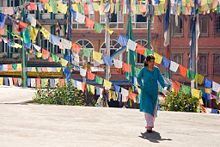
Traditionally, prayer flags come in sets of five, one in each of five colors. The five colors represent the elements,[2]the Five Pure Lights, and are arranged from left to right in a specific order. Each of the elements are associated with colors for specific traditions, purposes and sadhana:
- Blue (symbolizing sky/space)
- White (symbolizing air/wind)
- Red (symbolizing fire)
- Green (symbolizing water)
- Yellow (symbolizing earth)[2]
Symbols and prayers
The center of a prayer flag traditionally features a "Ta" (powerful or strong horse) bearing three flaming jewels (specifically ratna) on its back. The Ta symbolizes speed and the transformation of bad fortune to good fortune. The three flaming jewels symbolize the Buddha, the Dharma (Buddhist teachings), and the Sangha (Buddhist community), the three cornerstones of Tibetan philosophical tradition.
Approximately various versions of twenty traditional mantras (powerful ritual utterances) surround the Ta, each dedicated to a particular deity. In Tibetan religion, deities represent aspects of the divine manifest in each part of the whole non-dual universe, including individual humans). Those writings include mantras from three of the great Buddhist Bodhisattvas: Padmasambhava (Guru Rinpoche), Avalokiteśvara (Chenrezig, the bodhisattva of compassion, and the patron of the Tibetan people), and Manjusri.
In addition to mantras, prayers for the long life and good fortune of the person who mounts the flags are often included. Images (or the names) of four powerful animals (also known as the Four Dignities), the dragon, the garuda (a wise eagle-like bird), the tiger, and the Snowlion, adorn each corner of a flag.
Symbolism and tradition
Traditionally, prayer flags are used to promote peace, compassion, strength, and wisdom. The flags do not carry prayers to 'gods,' a common misconception, rather the Tibetans believe the prayers and mantras will be blown by the wind to spread the good will and compassion into all pervading space. Therefore, prayer flags are thought to bring benefit to all.
By hanging flags in high places the "Wind Horse" will carry the blessings depicted on the flags to all beings. As wind passes over the surface of the flags which are sensitive to the slightest movement of the wind, the air is purified and sanctified by the Mantras.
The prayers of a flag become a permanent part of the universe as the images fade from exposure to the elements. Just as life moves on and is replaced by new life, Tibetans renew their hopes for the world by continually mounting new flags alongside the old. This act symbolizes a welcoming of life changes and an acknowledgment that all beings are part of a greater ongoing cycle.
Timing of Hanging and Taking Down
Some believe that hanging the flags on inauspicious astrological dates may bring misfortune for as long as they are flying. Devotees believe that sunny mornings and windy days are the best time to put up new prayer flags.
Tradition calls for sets of five colored flags set up in the following order: blue, white, red, green, yellow from left to right. Those colors represent the Five Buddha Families and the five elements.
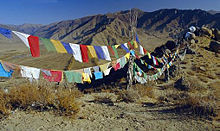
The origin of Prayer flags traces to the ancient "Bön" tradition of Tibet where shamanistic Bonpo used primary-colored plain flags in healing ceremonies. According to Traditional Tibetan medicine, the balance of the five elements fosters health and harmony.[2]
Buddhist replace old prayer flags with new ones annually on the Tibetan New Year. The symbols and mantras on prayer flags being sacred, tradition calls for treating them with respect. They should not be placed on the ground or used in clothing. Old prayer flags should be burned. During the Cultural Revolution, the communists discouraged prayer flags but still tolerated them. Many traditional designs may have been lost. Currently, different styles of prayer flags can be seen all across the Tibetan region. Most of the traditional prayer flags today have been made in Nepal and India by Tibetan refugees or by Nepali Buddhists. The flags are also manufactured in Bhutan for local use.
Gallery
- Prayer Flags in Wind.jpg
Tibetan Buddhist Prayer Flags in the wind.
- Nepal Prayer flag.jpg
The Solukhumbu region, looking back at a brilliant Lhotse and Everest shining in the rare (in April) evening sun behind a prayer flag pole.
- Prayer flags Gangtok Sikkim.jpg
En route to the main monastery in Gangtok (Sikkim) India.
- Small Tibetan prayer flags.jpg
Tibetans believe that the prayers (or blessings) printed on each flag in Tibetan script are activated by the physical motion of blowing wind and are thus transmitted outward into the cosmos. The flags will eventually fade, tear, and disintegrate into nothingness, which is a perfect analogy for the nature of personal consciousness in the Buddhist worldview.
See also
- Prayer wheel
- Stupas
- Tibetan Buddhism
- Phurba
- Bhutan
- Ladakh
Notes
- ↑ Colin Wilson. 1996. The atlas of holy places & sacred sites (New York: DK Pub.), pp. 10-12.
- ↑ 2.0 2.1 2.2 2.3 2.4 Radiant Heart: The Prayer Flag Tradition (PDF). prayerflags.com. Retrieved 2008-08-30.
- ↑ 3.0 3.1 Barker, p. 13
- ↑ 4.0 4.1 Beer, page 60
- ↑ 5.0 5.1 Wise, pp. 11-12
- ↑ Susie Carson Rijnhart. 1901. With the Tibetans in tent and temple; narrative of four years' residence on the Tibetan border, and of a journey into the far interior (Chicago: New York [etc.] F.H. Revell Co.), pp. 213, 359, 368.
- ↑ Theos Bernard. 1939. Penthouse of the gods; a pilgrimage into the heart of Tibet and the sacred city of Lhasa (New York: C. Scribner's Sons), p. 40.
ReferencesISBN links support NWE through referral fees
- Barker, Dian. 2003. Tibetan Prayer Flags. Connections Book Publishing. ISBN 1859061060.
- Beer, Robert. 2004. Encyclopedia of Tibetan Symbols and Motifs. Serindia Publications Inc. ISBN 1932476105
- Bernard, Theos. 1939. Penthouse of the gods; a pilgrimage into the heart of Tibet and the sacred city of Lhasa. New York: C. Scribner's Sons. OCLC 479926.
- Rijnhart, Mrs. Susie Carson. 1901. With the Tibetans in tent and temple; narrative of four years' residence on the Tibetan border, and of a journey into the far interior. Chicago: New York [etc.] F.H. Revell Co. OCLC 1517540.
- Wilson, Colin. 1996. The atlas of holy places & sacred sites. New York: DK Pub. ISBN 9780789410511.
- Wise, Tad. 2002. Blessings on the Wind: The Mystery & Meaning of Tibetan Prayer Flags. Chronicle Books. ISBN 0811834352.
External links
- Yolmo Lungta House & Exports. Retrieved August 30, 2008.
- DharmaCollection.com. Retrieved August 30, 2008.
- TibetanPrayerFlag.com. Retrieved August 30, 2008.
- Dharma Shop: Glossary. Retrieved August 30, 2008.
Template:Buddhism2
Credits
New World Encyclopedia writers and editors rewrote and completed the Wikipedia article in accordance with New World Encyclopedia standards. This article abides by terms of the Creative Commons CC-by-sa 3.0 License (CC-by-sa), which may be used and disseminated with proper attribution. Credit is due under the terms of this license that can reference both the New World Encyclopedia contributors and the selfless volunteer contributors of the Wikimedia Foundation. To cite this article click here for a list of acceptable citing formats.The history of earlier contributions by wikipedians is accessible to researchers here:
The history of this article since it was imported to New World Encyclopedia:
Note: Some restrictions may apply to use of individual images which are separately licensed.
